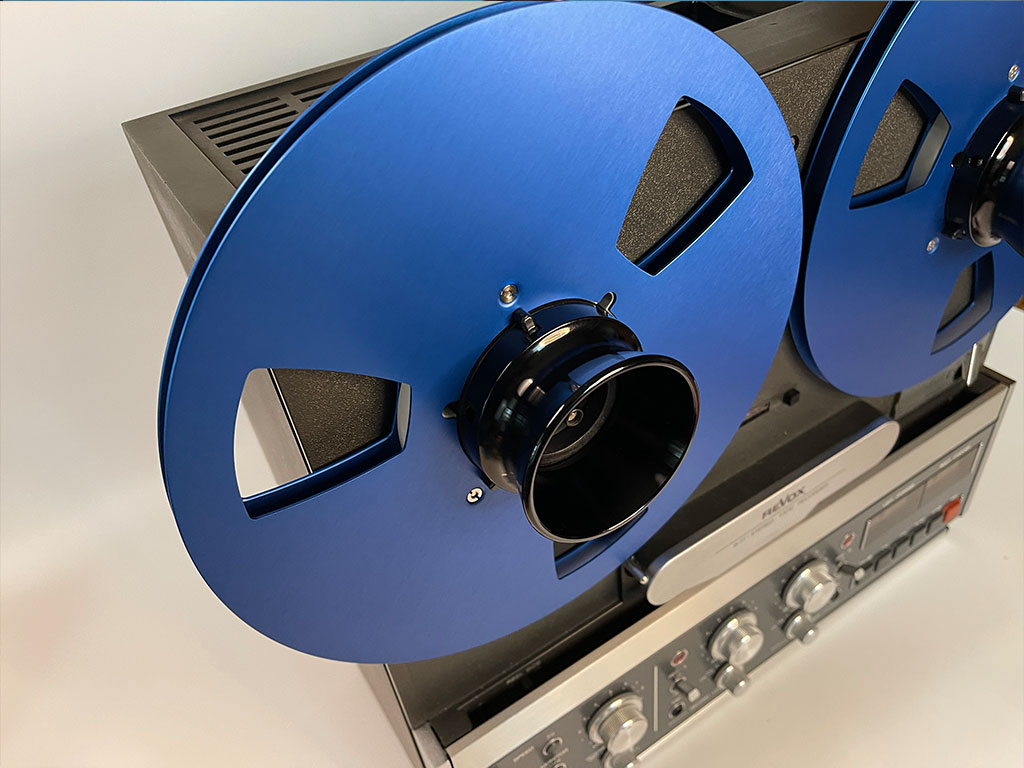Welcome to the world of reel-to-reel recording! This method of audio recording offers unparalleled sound quality that is sought after by professional musicians and audiophiles alike. However, achieving high-quality recordings requires proper techniques and equipment. In this article, we will cover everything you need to know about reel-to-reel recording tips and professional reel-to-reel recording techniques.
Understanding the Basics of Reel-to-Reel Recording
Reel-to-reel recording is an analog method for capturing sound that uses magnetic tape and reels. It is a classic technique that has been used in professional recording studios for decades, offering a unique warmth and depth that digital recording often lacks. If you are new to this method of recording, this tutorial will provide you with all the basics you need to get started.Equipment Needed
To start recording using reel-to-reel, you will need a few key pieces of equipment. These include a reel-to-reel recorder, microphone(s), and of course, reels of magnetic tape. Additionally, you may want to consider investing in headphones, a mixer, and other accessories to improve your recording setup.How it Works
At its most basic, reel-to-reel recording works by capturing sound waves onto magnetic tape through a process known as analog recording. This is done by using a microphone to capture sound, which is then amplified and sent to the recorder. The recorder then records the sound waves onto the magnetic tape as a series of magnetic impulses. When the tape is played back, the impulses are read by the recorder’s playback head and converted back into electrical signals. These signals are then amplified and sent to speakers to reproduce the original sound.Advantages of Reel-to-Reel Recording
One of the key advantages of reel-to-reel recording is the unique warmth and depth it can offer compared to other recording methods. This is partly due to the fact that it is an analog method, which can provide a more natural and organic sound than digital recording. Additionally, reel-to-reel recording offers a level of control over the recording process that is often unmatched by other methods. By adjusting tape speed, microphone placement, and other factors, you can achieve a high level of precision and customization in your recordings. If you are interested in trying out this classic recording method for yourself, follow the tips and techniques outlined in the rest of this article to achieve the best possible results.Choosing the Right Reel-to-Reel Tape
When it comes to reel-to-reel recording, choosing the right tape is crucial to achieving the best sound quality. Here are some best practices to keep in mind: Tape Speed: The speed at which the tape moves through the recorder affects the sound quality. Faster tape speeds generally result in better sound quality, but also use more tape. Choose the appropriate speed for your recording purpose. Tape Thickness: The thickness of the tape also affects sound quality. Thinner tapes are more prone to stretching and snapping, while thicker tapes are more durable. Again, choose the appropriate tape thickness for your recording purpose. Tape Brand: Different brands of tape have different characteristics that can affect sound quality. Experiment with different brands to determine which one works best for your recording purposes. Storage: Proper storage of reel-to-reel tapes is essential for maintaining sound quality. Store tapes in a cool, dry place away from direct sunlight and magnetic fields. Make sure tapes are not kept near any heat sources or other magnetic devices. Playback: When playing back reel-to-reel tapes, make sure the playback heads are clean and do not touch the tape. Also, avoid repeatedly rewinding and fast forwarding tapes, as this can cause them to wear out more quickly.Conclusion
By following these best practices for choosing and caring for reel-to-reel tapes, you can help ensure the longevity and quality of your recordings. Take the time to select the appropriate tape for your recording purposes and store it properly, and you’ll be able to enjoy your high-quality recordings for years to come.Setting Up Your Reel-to-Reel Recorder
Setting up your reel-to-reel recorder correctly is critical to achieving the highest possible recording quality. By following these professional reel-to-reel recording techniques, you can ensure that your recorder is calibrated perfectly for your needs.Calibrating Your Reel-to-Reel Recorder
Before you begin recording, you must calibrate your reel-to-reel recorder to ensure that it is set up correctly. This involves adjusting the bias, equalization, and level controls to match the characteristics of your tape and your recording environment. Firstly, set the bias and equalization controls to match the type of tape you are using. Adjust the levels so that the signal is neither too weak nor too strong. Use a test tone or a reference recording to ensure that the levels are correct.Threading the Tape
Threading the tape correctly is critical to achieving the best possible recording quality. Make sure the tape is threaded tightly and evenly across the heads and guides to minimize flutter and wow. Start by opening the tape deck and finding the supply and take-up reels. Thread the tape over the guide rollers and around the heads. Make sure the tape is taut and aligned with the heads. Thread the tape onto the take-up reel and then close the tape deck.Adjusting Playback Levels
Before you start recording, you must adjust the playback levels to ensure that you are capturing the best possible sound. Use headphones to monitor the sound and adjust the levels until the sound is clear and free of distortion. If the levels are too low, increase the input level until the sound is clear. If the levels are too high, decrease the input level until the sound is clear. Make sure there is no clipping or distortion in the sound, as this can damage the tape and degrade the sound quality. By following these professional reel-to-reel recording techniques, you can ensure that your recorder is set up perfectly for your needs, and that you achieve the highest possible recording quality.Tips for Optimal Reel-to-Reel Audio Quality: Positioning the Microphones
When it comes to reel-to-reel recording, the placement of your microphones can make all the difference in achieving optimal audio quality. Here are some tips to help you position your microphones like a pro:Consider the Microphone Type
The type of microphone you use will depend on the recording scenario. Dynamic microphones are ideal for recording loud sounds, such as drums or guitar amps, while condenser microphones are better suited for capturing delicate sounds, such as acoustic guitars or vocals. Choose the right microphone for the job to achieve the best sound quality.Experiment with Placement
The placement of your microphones can greatly affect the sound quality of your recording. For a natural sound, try the “3-to-1” rule: place your microphone three times the distance from the sound source as it is from any other source of sound in the room. This will help to minimize unwanted room noise and create a balanced sound. However, feel free to experiment with different microphone placements to find the perfect sound for your recording.Consider the Polar Pattern
The polar pattern of a microphone refers to the directionality of the sound it picks up. Some microphones, such as cardioid or supercardioid, have a directional pattern that focuses on the sound source and filters out background noise. Others, such as omnidirectional, pick up sound from all directions. Consider the polar pattern of your microphone when positioning it to ensure optimal sound quality. By following these tips, you can position your microphones like a pro and achieve optimal audio quality for your reel-to-reel recordings.Monitoring and Controlling Sound Levels
Professional reel-to-reel recording techniques are all about attention to detail. Monitoring and controlling sound levels is a critical aspect of achieving high-quality recordings. Here are some tips to keep in mind:Use headphones
Headphones are an essential tool for monitoring sound levels during reel-to-reel recording. They allow you to hear even the faintest sounds and adjust levels accordingly. Make sure to use high-quality headphones that are designed for studio use.Adjust input levels
Input levels determine the amount of sound that is recorded onto the tape. It’s important to adjust them properly to avoid distortion or clipping. Keep an eye on the levels as you’re recording, and make adjustments as needed.Avoid clipping
Clipping occurs when the sound level exceeds the maximum capacity of the recording equipment. To avoid clipping, keep an eye on the levels and adjust them as needed. You can also use a limiter to prevent peaks from exceeding the maximum level.Use a VU meter
A VU meter is a tool that measures the average level of audio over time. It can help you monitor the overall level of your recording and make adjustments as needed. Make sure to calibrate the meter properly to get accurate readings. By taking the time to monitor and control sound levels, you can ensure that your reel-to-reel recordings sound their best. These professional reel-to-reel recording techniques may seem simple, but they are essential for achieving high-quality results.Optimizing Recording Techniques
When it comes to reel-to-reel recording, adopting the right techniques can make all the difference in the final product. Below are some best practices for optimal reel-to-reel audio quality:Avoiding Signal Degradation
Signal degradation can cause a loss of sound quality in your recordings. To avoid degradation, keep your recording levels as high as possible without causing distortion. Additionally, avoid using low-quality equipment or degraded tapes as they can also contribute to signal degradation.Reducing Noise
Noise can interfere with the quality of your recordings. To reduce noise, make sure that your recording equipment is isolated from external sound sources such as air conditioning units or traffic. Additionally, use low-noise microphones and cables to reduce noise levels during recording.Utilizing Multi-Track Recording Capabilities
Multi-track recording is a useful tool for capturing multiple sound sources individually. This allows for more precise control over the final mix and can result in a higher quality recording. However, keep in mind that multi-track recording requires careful monitoring of each track to avoid phase issues or other interferences.Backing Up Your Recordings
Backing up your reel-to-reel recordings is crucial in ensuring that your hard work is not lost. Make sure to create copies of your recordings and store them in a safe place, such as a fireproof safe or an offsite storage facility. Consider digitizing your recordings for added security and ease of access. By implementing these best practices, you can achieve high-quality reel-to-reel recordings that will stand the test of time.Editing and Post-Production
Once you have recorded your audio, the next step is editing and post-production. This stage is vital to achieving a polished final product and requires professional reel-to-reel recording techniques. Here are some tips to help you through the process:Splicing Tape
When editing your audio, you may need to cut and splice the tape to remove unwanted sections or combine different recordings. To do this, use a sharp razor blade and carefully cut the tape at a 45-degree angle. Then, use a splicing block or tape to connect the two ends together. A well-spliced tape should have a smooth transition and not create any audible clicks or pops.Adding Effects
Reel-to-reel recorders typically do not have built-in effects, so you may need to add them during post-production. This can be done using external processing equipment or software plugins. When adding effects, be careful not to overdo it and maintain the natural quality of the recording.Mastering the Final Mix
Once you have completed your editing and added any necessary effects, it’s time to master the final mix. This involves adjusting the levels and EQ to create a balanced and cohesive sound, and preparing the audio for distribution. It’s important to use high-quality mastering equipment and professional reel-to-reel recording techniques to ensure optimal sound quality. By following these post-production tips, your reel-to-reel recordings will be transformed into professional, high-quality audio productions.Preserving and Caring for Reel-to-Reel Tapes
Reel-to-reel tapes are delicate and require proper storage and handling to maintain their longevity and high-quality sound. Here are some tips on how to care for your tapes:Storage Conditions
Tapes should be stored in a cool, dry, and dust-free environment away from direct sunlight and excessive heat or humidity. Ideally, tapes should be kept in airtight containers or bags to prevent moisture or dust from getting inside. Avoid storing tapes near magnetic fields or other electronic devices that could interfere with the tape’s magnetic signal.Playback Maintenance
Before playing a tape, inspect it for any signs of damage, such as kinks, wrinkles, or flaking. These can damage the playback heads and affect sound quality. Clean the tape path and playback heads regularly with a soft, lint-free cloth and isopropyl alcohol to remove dirt and debris. Be gentle when handling tapes and avoid touching the magnetic surface or exposing them to direct sunlight or moisture.Tape Cleaning
If tapes become dirty or sticky, they may need to be cleaned with a specialized tape cleaning solution. Use a product designed specifically for reel-to-reel tapes and follow the instructions carefully. Avoid using ordinary cleaning solutions or water, which can damage the tape’s surface and reduce sound quality.Playback Speed Maintenance
Over time, tapes may lose tension and stretch, causing changes in playback speed and pitch. To ensure accurate playback, it’s important to periodically check and adjust the tape’s tension and speed. Consult your recorder’s manual for instructions on how to calibrate the machine’s playback speed and adjust the tension of the tape.Final Thoughts
By following these simple tips, you can help ensure the longevity and optimal sound quality of your reel-to-reel tapes. Proper storage, handling, and maintenance are crucial in preserving your recordings for years to come. For more information on reel-to-reel recording, check out our reel-to-reel recording tutorial.Troubleshooting Common Issues
While reel-to-reel recording can produce high-quality sound, it is not without its challenges. Here are some common issues that may arise and how to troubleshoot them.Tape Alignment Problems
If you find that your recording sounds distorted, it may be due to tape alignment issues. This can occur when the tape heads are not properly aligned or when the tape is not threaded correctly. To resolve this, check the alignment of your tape heads and re-thread the tape, making sure it is properly aligned with the heads.Electrical Interference
Electrical interference can cause unwanted noise or hum in your recordings. This can be caused by nearby electrical devices or poor grounding. To resolve this, try moving your recording equipment away from other electrical devices and make sure your equipment is properly grounded.Tape Degradation
Over time, reel-to-reel tapes can degrade and lose their quality. This can result in a loss of sound clarity and fidelity. To minimize tape degradation, store your tapes in a cool, dry place and avoid exposing them to sunlight or extreme temperatures. You can also make copies of your tapes to preserve the original recordings.Additional Tips
Here are some additional tips to help troubleshoot any issues that may arise during your reel-to-reel recording sessions:- Use high-quality equipment to ensure optimal sound quality
- Adjust input levels to prevent clipping
- Check connections to make sure they are properly plugged in


























